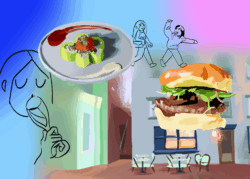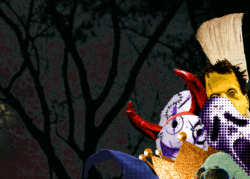If you take a stroll or a G2 bus down P Street toward Logan Circle, you’ll notice the upward gazing face of Barack Obama on the side of a small white roof. Though the image’s presence isn’t surprising—politics is inescapable in D.C., even when it isn’t election season—the stenciled blue and red portrait is striking and fresh, and stands apart from those stodgy logos on bumper stickers and window panes across the city. Step into the Irvine Contemporary gallery and you’ll discover the man behind the iconic portrait, and some of the most politically confrontational artwork to be found in the capital.

The familiar portrait of Obama, designed by urban artist Shepard Fairey and captioned by the word “HOPE,” is among the highlights of the politically concious exhibit “Regime Change Starts at Home.” The gallery may hardly seem fit to house the work of artists who have graced the Venice Biennale, New York’s MoMA, and numerous other major international museums, but the tiny Irvine Contemporary somehow pulls it off, proving that great art can come in small packages.
The exhibit showcases three artists working with a variety of media, styles, and political and religious causes, but they seem united on one front—creating artworks that are intelligent, meaningful and nice to look at. Sculptor Al Farrow crafts miniature, scaled replicas of mosques, temples, and Christian reliquaries which from a distance are incredibly beautiful, elegant works. A closer look reveals their components—artillery shells, guns, and human bone. The addition of the subtly disturbing is what lends his work a moving statement, and though the message is fairly straightforward, the level of craftsmanship is hard to come by and worth seeing up close.
Shepard Fairey’s work begins with a series of stenciled collages and paintings and harks back to his street artist roots as the exhibit moves outside the gallery, occupying a wall just beyond the back exit. Indoors, his Duality of Humanity series explores the dichotomy of war and peace, as one young soldier with a rifle bears a red flower on his cap, while another wears a peace sign and machine gun bullets around his neck. Fairey’s delicate layering of old newspaper ads, pretty Indian-flavored patterns, and subtle color transitions lighten his subject matter without detracting from the powerful statement on humanity and war.
In the next room, multimedia artist Paul D. Miller (aka DJ Spooky) showcases his project Manifesto for the People’s Republic of Antarctica, which includes a series of ironic propaganda posters and a video installation. Unfortunately, his posters pale compared to the more elaborately detailed works of Farrow and Fairey, and the video didn’t quite hit home for me. The work on its own is conceptually interesting but it can easily bore the casual viewer, at least next to the colorful, handcrafted works of the other two artists.
But the best part about the works isn’t their socio-political commentary. One doesn’t feel preached to when examining the oxidized bullets that top off a small Jewish temple. They remind viewers of the beauty of such manmade structures without ignoring the history of violence and religion. There is humor to some pieces—the reliquary of a trigger-pulling index finger, or the row of penguins lined up in support of a “communist Antarctica.” The exhibit makes an urgent but not heavy-handed statement, and when you pass by the boarded windows of Starbucks on M Street and see the row of Obama posters that bear Fairey’s design, at least you can appreciate the rarity of aesthetically-pleasing politics.





